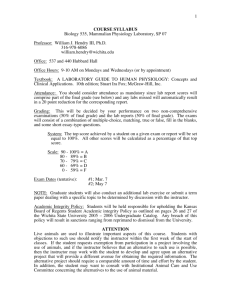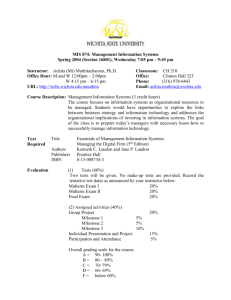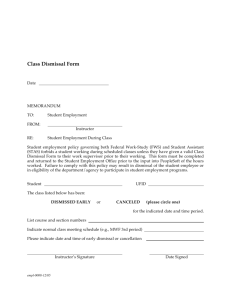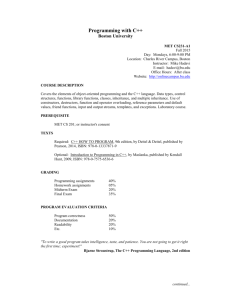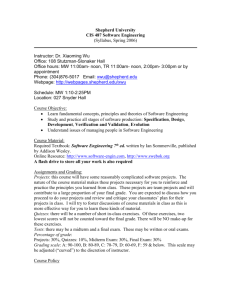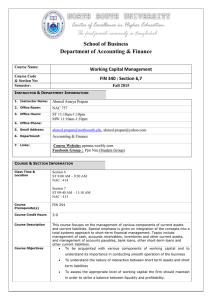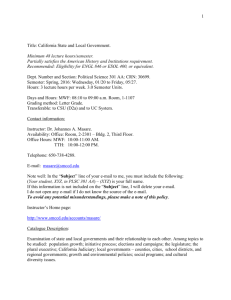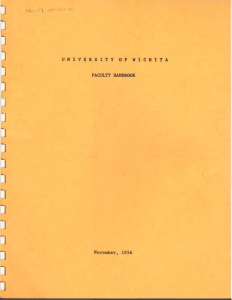Sylabus - Wichita State University
advertisement
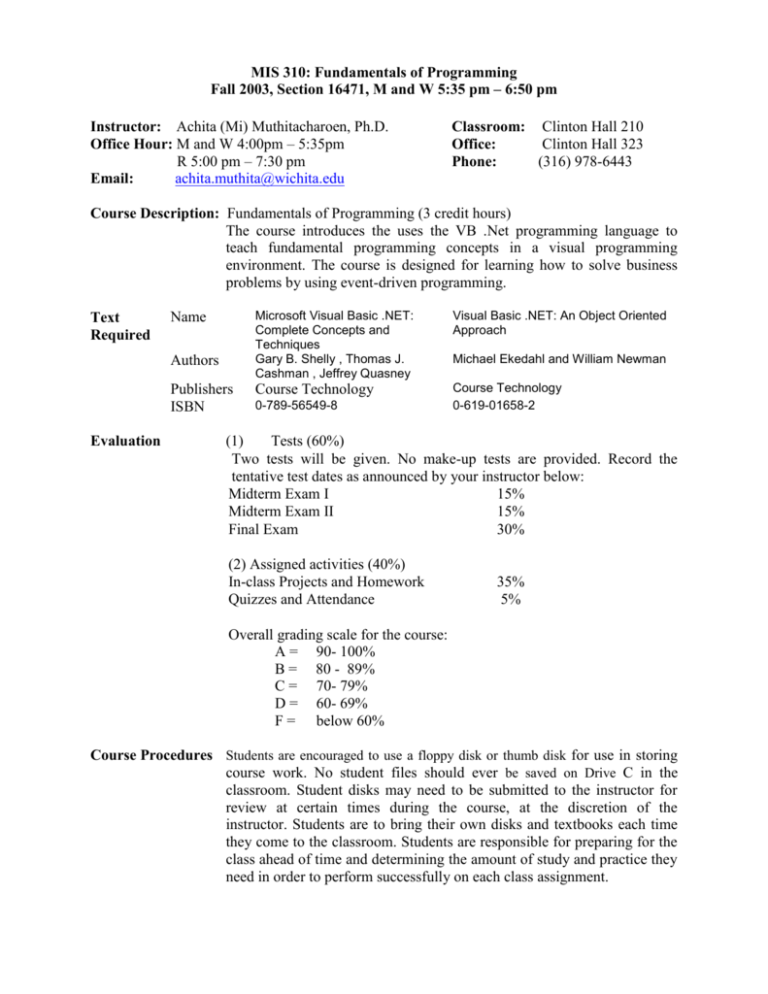
MIS 310: Fundamentals of Programming Fall 2003, Section 16471, M and W 5:35 pm – 6:50 pm Instructor: Achita (Mi) Muthitacharoen, Ph.D. Office Hour: M and W 4:00pm – 5:35pm R 5:00 pm – 7:30 pm Email: achita.muthita@wichita.edu Classroom: Clinton Hall 210 Office: Clinton Hall 323 Phone: (316) 978-6443 Course Description: Fundamentals of Programming (3 credit hours) The course introduces the uses the VB .Net programming language to teach fundamental programming concepts in a visual programming environment. The course is designed for learning how to solve business problems by using event-driven programming. Text Required Name Authors Publishers ISBN Evaluation Microsoft Visual Basic .NET: Complete Concepts and Techniques Gary B. Shelly , Thomas J. Cashman , Jeffrey Quasney Visual Basic .NET: An Object Oriented Approach Course Technology Course Technology 0-619-01658-2 0-789-56549-8 Michael Ekedahl and William Newman (1) Tests (60%) Two tests will be given. No make-up tests are provided. Record the tentative test dates as announced by your instructor below: Midterm Exam I 15% Midterm Exam II 15% Final Exam 30% (2) Assigned activities (40%) In-class Projects and Homework Quizzes and Attendance 35% 5% Overall grading scale for the course: A = 90- 100% B = 80 - 89% C = 70- 79% D = 60- 69% F = below 60% Course Procedures Students are encouraged to use a floppy disk or thumb disk for use in storing course work. No student files should ever be saved on Drive C in the classroom. Student disks may need to be submitted to the instructor for review at certain times during the course, at the discretion of the instructor. Students are to bring their own disks and textbooks each time they come to the classroom. Students are responsible for preparing for the class ahead of time and determining the amount of study and practice they need in order to perform successfully on each class assignment. Academic Integrity “A standard of honesty, fairly applied to all students, is essential to a learning environment. Students violating such standards must accept the consequences; penalties are assessed by appropriate classroom instructors or other designated people. Serious cases may result in discipline at the college or university level and may result in suspension or dismissal. Dismissal from a college for academic dishonesty constitutes dismissal form the university.” This is an excerpt from the Student Code of Conduct. The complete code may be found online at the WSU Policies and Procedures Manual at http://webs.wichita.edu/inaudit/ch8_05.htm . Recommended ADA Statement for Syllabus: If you have a physical, psychiatric/emotional, or learning disability that may impact on your ability to carry out assigned course work, I encourage you to contact the Office of Disability Services (DS). The office is located in Grace Wilkie Annex, room 151, 978-3309 (voice/tty). DS will review your concern and determine, with you, what academic accommodations are necessary and appropriate for you. All information and documentation of your disability is confidential and will not be released by DS without your written permission. Academic Policies for Students: See http://webs.wichita.edu/senate/handbook/CHAPTER5.html Conduct Your instructor will adhere to university policies related to cheating and class conduct. (Refer to the Student Handbook sections on Academic Misconduct and Classroom Misconduct for information.) One item in the handbook specifies that students are not to cause disturbances in the classroom. In addition to improper classroom behavior, any behavior that is distracting for other students or for your instructor is not allowed. Examples include bringing non-enrolled guests or bringing telephones or pagers that ring or beep during class. No food or beverages are allowed in the classroom. The syllabus and tentative schedule are subject to change. TENTATIVE SCHEDULE Date Aug Topics Dues 25 Chapter 1 (Book 1): An Introduction to Visual Basic .NET and 27 Chapter 2 (Book 1): The Visual Basic .NET Integrated Program Design Project I Development Environment (Brief discussion) Sept 1 Labor Day 3 Chapter 3 (Book 1): Building an Application in the Visual Basic 8 Use Exercise in Ch. 3 Book 1 w/ some topics in Ch.1 and Ch.2 Book 2 Chapter 4 Book 1: Working with Variables, Constants, Data .NET Environment 10 Project II Types, and Expressions Chapter 3 Book 2: Data Types and Variables 15 HW I 17 22 Project III 24 29 Oct Midterm Exam I Chapter 5 (Book 1) and Chapter 4 (Book 2) : Decision Making HW II Date Time Structure (Book 2, Ch. 4) Project IV Chapter 6 (Book 1): Repetition and Multiple Forms HW III 1 6 8 13 15 20 Fall Break 22 Midterm Exam II 27 Chapter 7 (Book 1): Using Menus, Common Dialogs, Procedures, Functions, and Array 29 Nov 3 Project V 5 10 Chapter 8 (Book 2): Introduction to Database Processing 12 17 19 HW IV Chapter 9: Working with Multiple Database Table 24 26 Dec Project VI Thanks Giving 1 3 HW V Chapter 11(Book 1): Creating Web Applications and Writing Data to a Database 8 10 15 Final Exam (5:40 pm – 7:30 pm) Possible Topics to Cover: Chapter 13, Chapter 14, and Appendix C in Book II Note: Tentative schedule and class assignments are subject to change. Project VII
